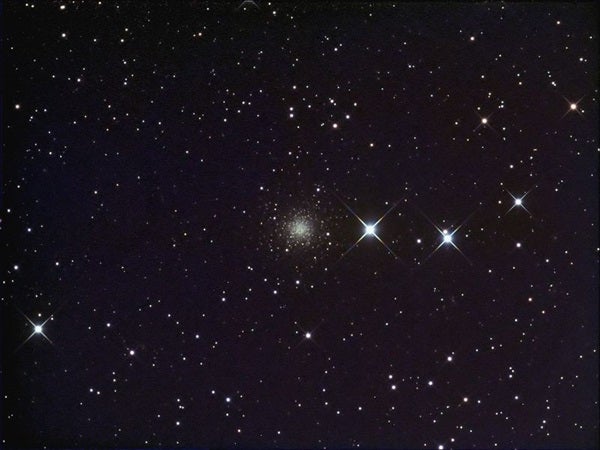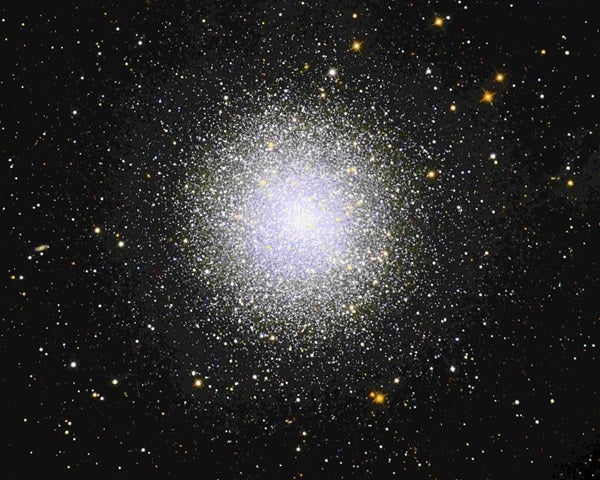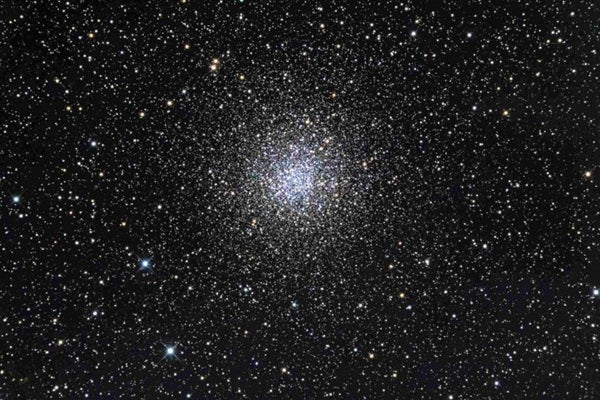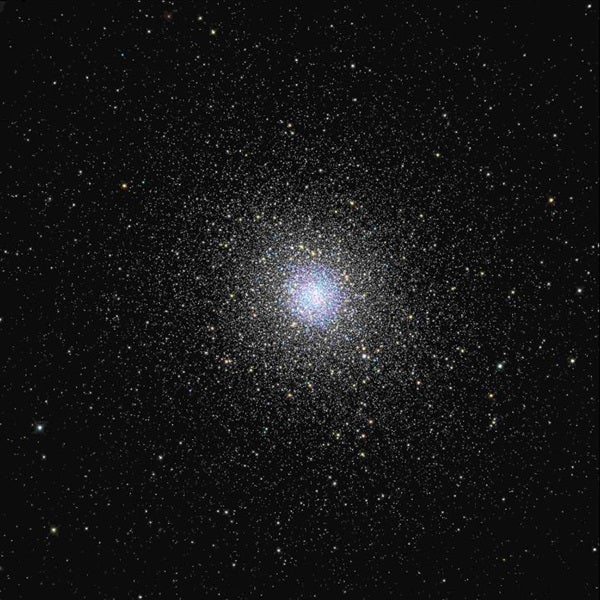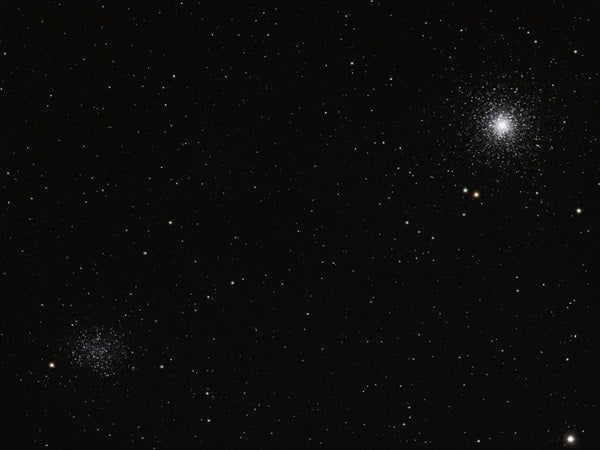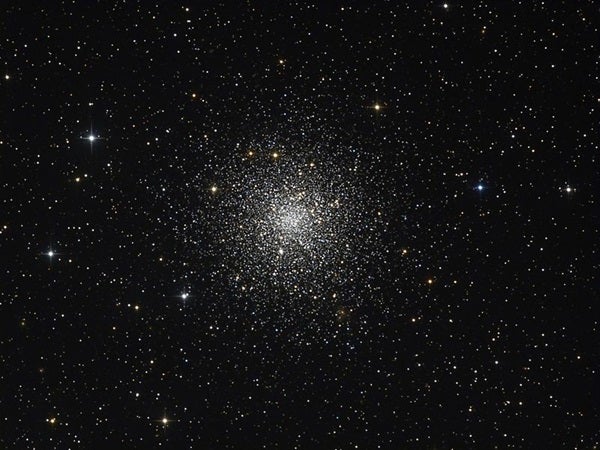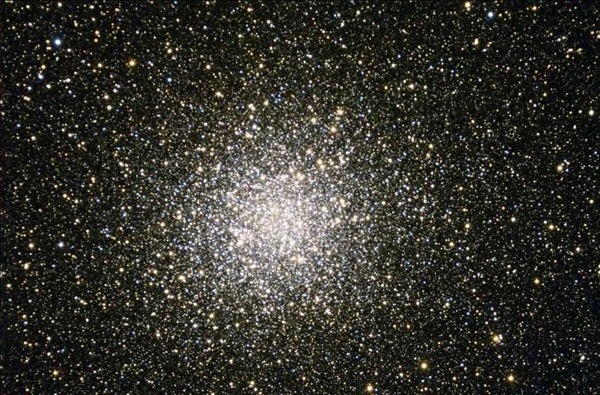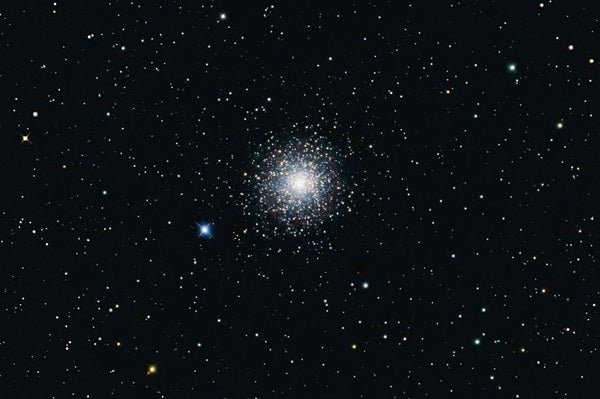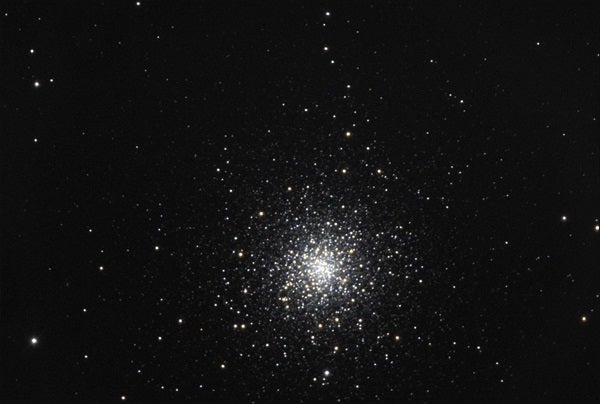Spring
Let’s begin with the faintest object on the list, which, admittedly, is a nontraditional opener. But in this case, it’s well worth a look because, at a distance of 275,000 light-years, it’s one of our galaxy’s most remote globulars. The Intergalactic Wanderer (NGC 2419) lies in Lynx, itself a fairly dim constellation. A good way to locate the magnitude 10.5 glob is to search the star-poor region 7° north of Castor (Alpha [α] Geminorum). If you use a magnification of 200x or greater in an 8-inch or larger telescope, you’ll see a 4′-diameter fuzzball with a slightly brighter center ringed by a fainter halo that’s not uniformly lit.
From the faintest glob, we head to the one farthest south, NGC 3201 in Vela. At magnitude 6.8, it’s quite easy to spot through a finder scope about 6° west-northwest of Mu (μ) Velorum. The first thing you’ll notice is how big it is — 0.3° in diameter.
A 4-inch scope reveals only a crowd of unresolvable stars at the cluster’s bright center. A 10-inch or larger instrument will reveal more than 100 stars. At powers above 200x, a moderately dark but shallow V-shaped indentation is apparent on the globular’s southern side.
The first Messier object on our list, M68 in Hydra, glows at magnitude 7.6 and measures 12′ across. To find it, look 3.5° south-southeast of Kraz (Beta [β] Corvi).
When you look at the fourth object on the list, M53 in Coma Berenices, you’re getting a two-for-one treat. It glows at magnitude 7.7 and spans a worthy 12.6′. To spot it, just point your scope 1° northeast of Diadem (Alpha Comae Berenices).
Through a 4-inch scope under a dark sky, you’ll resolve more than a dozen outlier stars. But most of M53’s stars lie at the cluster’s center. Because this region of sky doesn’t contain many stars visible through small scopes, you’ll easily define the glob’s edge.
The second part of this treat is NGC 5053, which you’ll spot in the same low-power field of view as M53. At magnitude 9.9, it’s noticeably fainter than its partner, although with a diameter of 10.5′, they have comparable sizes. That, however, is where the similarity ends. With just a few dozen widely spaced stars visible, NGC 5053 looks more like an open cluster than a globular. But take in the big picture and see if you can pick out its roughly triangular shape.
Moving on, we come to the second-brightest glob in the spring sky, M3 in Canes Venatici. At magnitude 6.3, it’s visible to the naked eye for some observers. And, spanning 16.2′, it’s more than half the diameter of the Full Moon. You’ll find it midway between Arcturus (Alpha Boötis) and Cor Caroli (Alpha Canum Venaticorum).
We end our springtime hunt for globulars with the brightest of the season — and, indeed, the brightest in the Northern Hemisphere sky: M5 in Serpens Caput. This great object glows at magnitude 5.7 and measures 17.4′ across.
To find it, look 12° north of Zubeneschamali (Beta Librae). Sharp-eyed observers can spot M5 from a dark site without optical aid. If your eyes are up to the task, you’ll first spot the 5th-magnitude star, 5 Serpentis, 22′ southeast of M5. The star is twice as bright as the cluster.
M5 explodes with detail through any size telescope. That said, a 4-inch scope will reveal just a few dozen stars, while an 11-inch will expose more than 100. At a magnification of 150x or more, you’ll see that M5 has a grainy structure and that its core is condensed, making up about 25 percent of the cluster’s diameter. Make sure to also look for the many streamers of stars emanating from its core.
Summer
More globulars populate the summer sky than during any other season. Our starting point will be M80 in Scorpius, one of the easiest globs to find. It lies midway between Antares (Alpha Scorpii) and Graffias (Beta Sco).
Although you’ll spot this magnitude 7.3 object through any scope, instruments with apertures less than 8 inches won’t reveal much. M80, which spans 8.9′, is quite condensed. One particular star you’ll surely spot is magnitude 8.5 SAO 184288, a foreground star that lies at the northeastern edge of the cluster.
Two more globs lie in the northern part of Scorpius. The first is M4. To find it, just center Antares in your eyepiece and M4 will be to its west. This terrific object glows at magnitude 5.4 and, at 26.3′ wide, has a diameter 85 percent that of the Full Moon.
A 6-inch telescope will let you see 20 or so stars scattered loosely across M4’s face. Notice the chain of stars running north to south through the cluster’s center. Through a 12-inch or larger scope cranked up to magnifications of 200x or more, you’ll see several hundred stars, which subdivide into varied patterns that hide the central chain.
Now, head north from Scorpius to find the Hercules Cluster (M13), which, at magnitude 5.8, is second in brightness only to M5 in the northern half of the sky. M13 is more than 30° higher, however, so observers target it much more often. This globular also appears brighter than M5 to most observers because it’s slightly smaller, spanning 16.6′. That makes its surface brightness a bit higher than M5’s.
To find M13, look two-thirds of the way from Zeta (ζ) to Eta (η) Herculis. Through an 8-inch or larger scope, this glob has character. Use an eyepiece that gives a magnification of 200x or more and you’ll see the Propeller, a Y-shaped region of three dark lanes near the core. High powers also cut the brilliance of M13’s core, which can mask some of the details visible at the edge of the cluster.
Our next two treats lie in Ophiuchus. M12 lies 7.7° east-northeast of Yed Posterior (Epsilon [ε] Ophiuchi) and glows at magnitude 6.1, which makes it barely visible to the naked eye from a dark site.
Through a 4-inch telescope, you’ll see a faint halo around a tiny core. A 10-inch scope at high power, however, gives a deep view, resolving the cluster into hundreds of stars. This is when you’ll notice how evenly distributed the stars are and how irregular M12’s edge appears.
Through a 4-inch telescope, the biggest difference between M10 and M12 is that M10’s core appears brighter. It, too, has a faint halo of stars. Larger telescopes show both the halo’s richness and how its brightness slowly decreases with distance from the core.
For our next globular, head back to Hercules to home in on its second-brightest glob, M92. This treat glows at magnitude 6.5 and measures 11.2′ in diameter. You’ll find it 6° north of Pi (π) Herculis.
Even small scopes will resolve many of this cluster’s stars, and a 6-inch at 100x shows that M92 is slightly oval, stretching north to south. Larger instruments reveal a large, concentrated core surrounded by a halo of hundreds of faint stars.
We’ll end our summer section with a trio of globs in Sagittarius. Start by pointing your scope 1° northwest of Lambda (λ) Sagittarii for the faintest of the three, M28, which glows at magnitude 6.9. An 8-inch telescope will let you resolve a few dozen stars in its wide halo, which spans 11.2′. Look closely to spot a bright chain of stars to the north and a fainter one to the north-northwest. Observers have reported a three-dimensional aspect to M28 through larger scopes and magnifications of 250x or more.
Next up is M22, the third-brightest globular cluster in the sky, surpassed only by Omega Centauri (NGC 5139) and 47 Tucanae (NGC 104), both of which lie much farther south. This wonder gleams at magnitude 5.2 and measures 24′ across. Unfortunately, it’s a southern object, which means northern observers must observe it through lots of atmosphere. To find M22, look 2.4° northeast of Kaus Borealis (Lambda Sagittarii).
A 4-inch scope will resolve 20 or more stars against a rich background. Your first task is to find the cluster’s edge. An 8-inch or larger instrument will saturate the field of view with hundreds of stars. Spend some time looking for the many patterns (arrowheads, chains, geometric shapes) that are visible.
Large scopes with eyepieces that provide high powers (300x and above) will reveal several hundred faint stars. And here’s something fun you can try: Insert an eyepiece with a tiny field of view. Through it, M55 looks more like an open cluster than a glob.
Fall and winter
You might think that after the summer barrage of globulars, there are none left. That’s not quite true. The best of autumn’s three objects is M15 in Pegasus. It glows at magnitude 6.2 and spans 12.3′. To find it, draw a line from Theta (θ) to Epsilon Pegasi and extend it 4°.
A 4-inch scope will resolve dozens of stars around M15’s bright central region. Observers specifically target the cluster’s attractive chains of stars. Because of their position, M15 may appear slightly oval through a small scope.
If you head south to Aquarius and look about 5° north of Beta Aquarii, you’ll encounter one of my favorite globulars: M2. This stellar beehive glows at magnitude 6.6 and measures 12.9′ across. Even a small telescope will reveal M2’s slightly elliptical shape, although more northerly observers will need steady air near the southern horizon. It’s worth the wait.
While you’re in M2’s neighborhood, head west one constellation and locate M30 in Capricornus. To find this magnitude 6.9 glob, look about 3° east-southeast of Zeta Capricorni.
M30 has a diameter of 11′. Through a small scope, you’ll see lots of resolvable stars surrounding a large, bright core. To resolve that region, you’ll need a 12-inch scope and a magnification of 300x or more.
Our final object is the lone entry from the winter sky. M79 in Lepus glows at magnitude 7.8 and spans 8.7′. To find it, draw a line from Alpha through Beta Leporis and extend it 3.5°.
Small scopes don’t reveal much detail in M79. However, a 10-inch instrument shows a bright, wide core. Use a magnification of 200x or more, and you’ll resolve scores of stars at the cluster’s edges.
The sky beckons
I hope this list has shown you that the universe of globular clusters is a rewarding one to observe. Indeed, I expect you’ll add many more details to the few that I’ve provided for each of these fascinating objects. Good luck!

